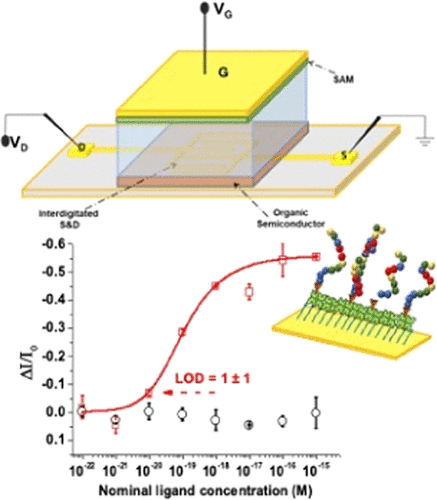Our official English website, www.x-mol.net, welcomes your
feedback! (Note: you will need to create a separate account there.)
Organic Field-Effect Transistor Platform for Label-Free, Single-Molecule Detection of Genomic Biomarkers.
ACS Sensors ( IF 8.2 ) Pub Date : 2020-06-04 , DOI: 10.1021/acssensors.0c00694 Eleonora Macchia 1 , Kyriaki Manoli 2 , Cinzia Di Franco 2, 3 , Rosaria Anna Picca 2 , Ronald Österbacka 1 , Gerardo Palazzo 2, 4 , Fabrizio Torricelli 5 , Gaetano Scamarcio 3, 6 , Luisa Torsi 1, 2, 4
ACS Sensors ( IF 8.2 ) Pub Date : 2020-06-04 , DOI: 10.1021/acssensors.0c00694 Eleonora Macchia 1 , Kyriaki Manoli 2 , Cinzia Di Franco 2, 3 , Rosaria Anna Picca 2 , Ronald Österbacka 1 , Gerardo Palazzo 2, 4 , Fabrizio Torricelli 5 , Gaetano Scamarcio 3, 6 , Luisa Torsi 1, 2, 4
Affiliation

|
The increasing interest in technologies capable of tracking a biomarker down to the physical limit points toward new opportunities in early diagnostics of progressive diseases. Indeed, single-molecule detection technologies are foreseen to enable clinicians to associate the tiniest increase in a biomarker with the progression of a disease, particularly at its early stage. Bioelectronic organic transistors represent an extremely powerful tool to achieve label-free and single-molecule detection of clinically relevant biomarkers. These electronic devices are millimetric in size and in the future could be mass-produced at low cost. The core of the single molecule with a large transistor (SiMoT) platform, based on an electrolyte-gated field-effect transistor, is a gold gate electrode biofunctionalized with a self-assembled monolayer, a densely packed layer of recognition elements. So far, only the SiMoT detection of proteins, using the corresponding antibodies as recognition elements, has been reported. In this study, the SiMoT sensing response toward genomic biomarkers is proposed. Herein, the gate is functionalized with a genomic biomarker for multiple sclerosis (miR-182). This is relevant, not only because a limit of detection of a single molecule is achieved but also because it proves that the SiMoT label-free, single-molecule detection principle is the only one of its kind that can detect, by means of the same platform, both protein and genomic markers.
中文翻译:

有机场效应晶体管平台,用于基因组生物标记物的无标记,单分子检测。
人们对能够追踪生物标记物直至物理极限的技术的兴趣日益浓厚,这为进行性疾病的早期诊断提供了新的机会。实际上,预见到单分子检测技术将使临床医生能够将生物标志物最小的增加与疾病的进展相关联,特别是在疾病的早期阶段。生物电子有机晶体管代表了实现临床相关生物标记物的无标记和单分子检测的极为强大的工具。这些电子设备的尺寸为毫米,将来可能以低成本大量生产。具有大分子晶体管(SiMoT)平台的单分子的核心,是基于电解质门控场效应晶体管的,是通过自组装单层生物功能化的金栅电极,密集的识别元素层。迄今为止,仅报道了使用相应抗体作为识别元件的蛋白质的SiMoT检测。在这项研究中,提出了对基因组生物标记物的SiMoT感应响应。在这里,门是用多发性硬化症的基因组生物标志物(miR-182)功能化的。这是有意义的,不仅因为达到了对单个分子的检测极限,而且还因为它证明了不含SiMoT标签的单分子检测原理是唯一可以通过该方法检测的分子。平台,包括蛋白质和基因组标记。提出了对基因组生物标记物的SiMoT传感响应。在这里,门是用多发性硬化症的基因组生物标志物(miR-182)功能化的。这是有意义的,不仅因为达到了对单个分子的检测极限,而且还因为它证明了不含SiMoT标签的单分子检测原理是唯一可以通过该方法检测的分子。平台,包括蛋白质和基因组标记。提出了对基因组生物标记物的SiMoT传感响应。在这里,门是用多发性硬化症的基因组生物标志物(miR-182)功能化的。这是有意义的,不仅因为达到了对单个分子的检测极限,而且还因为它证明了不含SiMoT标签的单分子检测原理是唯一可以通过该方法检测的分子。平台,包括蛋白质和基因组标记。
更新日期:2020-06-26
中文翻译:

有机场效应晶体管平台,用于基因组生物标记物的无标记,单分子检测。
人们对能够追踪生物标记物直至物理极限的技术的兴趣日益浓厚,这为进行性疾病的早期诊断提供了新的机会。实际上,预见到单分子检测技术将使临床医生能够将生物标志物最小的增加与疾病的进展相关联,特别是在疾病的早期阶段。生物电子有机晶体管代表了实现临床相关生物标记物的无标记和单分子检测的极为强大的工具。这些电子设备的尺寸为毫米,将来可能以低成本大量生产。具有大分子晶体管(SiMoT)平台的单分子的核心,是基于电解质门控场效应晶体管的,是通过自组装单层生物功能化的金栅电极,密集的识别元素层。迄今为止,仅报道了使用相应抗体作为识别元件的蛋白质的SiMoT检测。在这项研究中,提出了对基因组生物标记物的SiMoT感应响应。在这里,门是用多发性硬化症的基因组生物标志物(miR-182)功能化的。这是有意义的,不仅因为达到了对单个分子的检测极限,而且还因为它证明了不含SiMoT标签的单分子检测原理是唯一可以通过该方法检测的分子。平台,包括蛋白质和基因组标记。提出了对基因组生物标记物的SiMoT传感响应。在这里,门是用多发性硬化症的基因组生物标志物(miR-182)功能化的。这是有意义的,不仅因为达到了对单个分子的检测极限,而且还因为它证明了不含SiMoT标签的单分子检测原理是唯一可以通过该方法检测的分子。平台,包括蛋白质和基因组标记。提出了对基因组生物标记物的SiMoT传感响应。在这里,门是用多发性硬化症的基因组生物标志物(miR-182)功能化的。这是有意义的,不仅因为达到了对单个分子的检测极限,而且还因为它证明了不含SiMoT标签的单分子检测原理是唯一可以通过该方法检测的分子。平台,包括蛋白质和基因组标记。











































 京公网安备 11010802027423号
京公网安备 11010802027423号